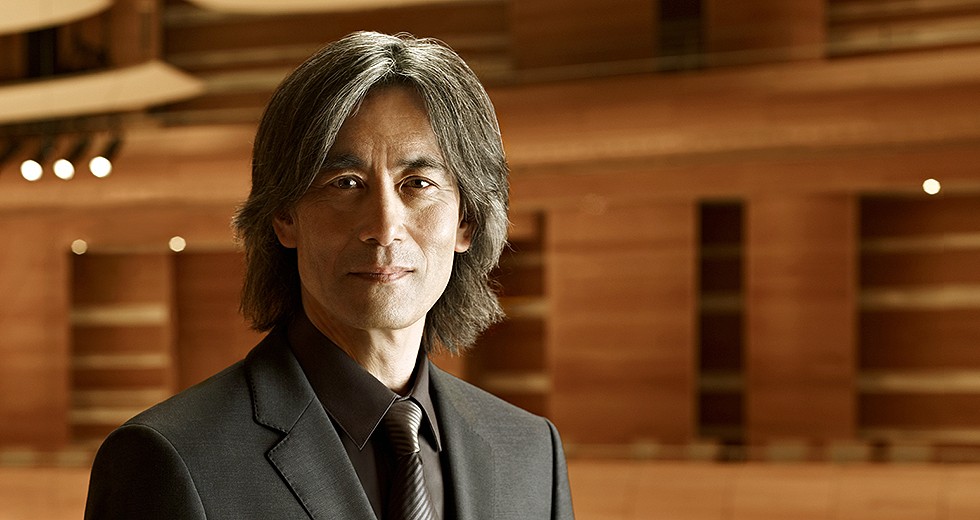
“When we were children growing up, we all thought Stravinsky was a Californian,” says Kent Nagano, Montreal’s maestro via Morro Bay, as he recalled the Russian émigré composer. “We thought of him as American.”
Nagano celebrates 10 seasons atop the Orchestre symphonique de Montréal with a cross-country journey from New York to Berkeley this month; his merry band, tuning up and turning on Stravinsky’s Rite of Spring, finishes the tour with a Ken Kesey-esque flourish on a road trip along the California coast. Meanwhile, Montreal’s magic bus pulls up to Orchestra Hall for an SCP Orchestra Series concert March 18.
“I haven’t thought of Ken Kesey for a long time,” the bemused Nagano allows of the coastal scribe immortalized in Tom Wolfe’s 1968 non-fiction book Electric Kool-Aid Acid Test. In any case, many dynamic cultural collisions from Nagano’s California youth seem to shape the Montreal maestro’s expansive music making and inclusive world view.
WAVES
Halfway between San Francisco and Los Angeles, Morro Bay juts into the Pacific just south of San Simeon where William Randolph Hearst jammed the globe’s treasures into his eclectic hilltop refuge. Nagano’s own California crested at Morro Rock, a coastal volcanic dome engulfed by the intellectual tides of a world in flight. “The California in which I grew up, Morro Bay included, was still very strongly impacted by the waves of immigration that took place just before the First World War, just after the First World War and especially during the Second World War,” he recalls.
Nagano’s parents, Californians of Japanese heritage, turned their university training to a family farm his grandfather started. “Our particular farm was surrounded by immigrants from Italy, from France, from Germany, from Switzerland,” he says. The new Californians “filled our symphony orchestras, filled our universities and filled the roles of teachers” — his own included.
Central to his music education was a professor “who had to escape Munich,” he says, referring to Wachtang “Botso” Korisheli, a World War II refugee from Soviet Georgia. After fleeing Europe, Korisheli landed in Morro Bay (where passed away at age 93 in July). Korisheli, like many of Europe’s cultural lights, fled Nazi oppression for the West Coast’s sense of promise and optimism.
“We were children of immigrants and we also very strongly identified with being American, and for us, we just assumed — we thought of Stravinsky as an American, we thought of Schoenberg as an American, we thought of [conductor] Bruno Walter as an American. They all lived in Los Angeles,” as Nagano saw it, “a thriving and very inspirational artistic community that had a very strong impact on the arts in California in general.
“It was not at all unusual — you can say it was common then — to have the European culture directly as a source of perpetual thinking, of philosophical thinking, of artistic thinking and aesthetics.”
(His sense of the often staunch Quebecois culture is similarly inclusive. “One of the languages spoken here [in Montreal] is French. It’s not the only one. We speak English, we speak Italian, and we speak German in Quebec.” It’s a range that Nagano admires. “When one takes a plane from Europe and Paris, or Berlin or Vienna or London, and lands in Montreal you don’t feel any kind of a culture shock. It feels the same.”)
TREMORS
The ballerina Irina Nijinska, born in St. Petersburg like Stravinsky, taught Nagano about The Rite of Spring, the Russian composer’s seminal ballet, which her famous uncle Vaslav Nijinsky choreographed in its riotous 1913 debut. The work is a springtime pagan ritual reimagined by cold-weather Russians in rainy Paris — the daring polyglot that Nijinska related to Nagano years later in California, where it’s always sunny and 70.
“Probably most people are familiar with [The Rite of Spring] through the symphonic performances without the choreography, but it should also not be forgotten that the conception and the first performances were obviously based upon specific movements,” Nagano says. Nijinska collaborated with him on re-creating the abrupt, angular aesthetics of her uncle’s original conception, tying fractured visual rhythms to Stravinsky’s radical music. “To learn the score within this context was a profound influence and inspiration and, of course, it carries over until today,” the conductor says.
While Stravinsky’s Rite of Spring invites the strong sonic vibrancy Nagano has imbued in the OSM the past 10 seasons, at times the Morro Bay maestro’s mystical talk of orchestral intangibles evokes an Esalen workshop up the Big Sur coastline: “We think of rhythm as power. We think of rhythm as breathing — rhythm as something that’s supple, that’s flexible, that has a relationship with gravity, that is an organism independent from a place. And in that sense, bringing this very unique tradition to California, I think, will be a real chance for discovery out on the West Coast.
“A ritual has to be a little dangerous.”
That’s the risky timbre of Stravinsky’s pagan Rite in the grasp of the visionary conductor, but he speaks of that ritual echoing Kesey’s edgy words. “The rituals we are trying to put together, we don’t know what they are, but we feel the hunger for them,” the author himself said in the book Conversations with Ken Kesey. “Everywhere I go, I feel the hunger for people wanting to be a part of a ritual — not [just] to be there and have somebody present something to them.”
Nagano’s won’t accept passivity. He wants Montreal’s musicians and American audiences embracing the Rite that Stravinsky envisions, living and breathing a daring European polyglot that shook the world a century back. Its waves swept a next-generation California conductor on a coast where the earth still pitches. If you’re with this maestro you’ll sense these tremors — their arresting, turbulent pull. That’s the gravity of rhythm.